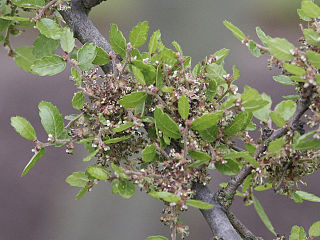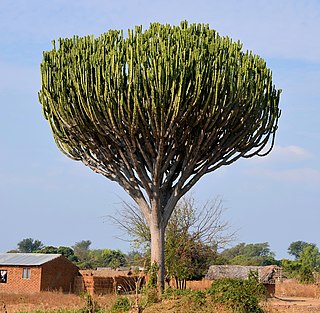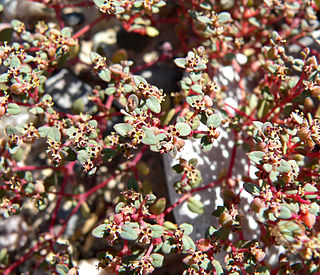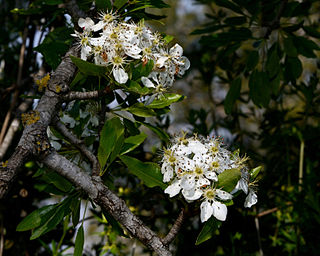
Mistletoe is the common name for obligate hemiparasitic plants in the order Santalales. They are attached to their host tree or shrub by a structure called the haustorium, through which they extract water and nutrients from the host plant.

Colchicum is a genus of perennial flowering plants containing around 160 species which grow from bulb-like corms. It is a member of the botanical family Colchicaceae, and is native to West Asia, Europe, parts of the Mediterranean coast, down the East African coast to South Africa and the Western Cape. In this genus, the ovary of the flower is underground. As a consequence, the styles are extremely long in proportion, often more than 10 cm (4 in). All species in the genus are toxic.

Rhamnus is a genus of about 140 accepted species of shrubs or small trees, commonly known as buckthorns, in the family Rhamnaceae. Its species range from 1 to 10 m tall and are native mainly in east Asia and North America, but found throughout the temperate and subtropical Northern Hemisphere, and also more locally in the subtropical Southern Hemisphere in parts of Africa and South America. One species, the common buckthorn, is able to flourish as an invasive plant in parts of Canada and the U.S., where it has become naturalized.

Viscum album is a species of mistletoe in the family Santalaceae, commonly known as European mistletoe, common mistletoe or simply as mistletoe. It is native to Europe and western and southern Asia.

Viscum is a genus of about 70–100 species of mistletoes, native to temperate and tropical regions of Europe, Africa, Asia and Australasia. Traditionally, the genus has been placed in its own family Viscaceae, but recent genetic research by the Angiosperm Phylogeny Group shows this family to be correctly placed within a larger circumscription of the sandalwood family, Santalaceae. Its name is the origin of the English word viscous, after the Latin viscum, a sticky bird lime made from the plants' berries.

Phoradendron is a genus of mistletoe, native to warm temperate and tropical regions of the Americas. The center of diversity is the Amazon rainforest. Phoradendron is the largest genus of mistletoe in the Americas, and possibly the largest genus of mistletoes in the world. Traditionally, the genus has been placed in the family Viscaceae, but recent genetic research acknowledged by the Angiosperm Phylogeny Group shows this family to be correctly placed within a larger circumscription of the sandalwood family, Santalaceae.

Zelkova abelicea is a species of tree in the family Ulmaceae. It is referred to by the common names Cretan zelkova, and on Crete proper as abelitsia (αμπελιτσιά). It is endemic to Crete. It is found in small numbers and is classified as Vulnerable on the IUCN red list of endangered species.
Umbilicus chloranthus is a species of flowering plant in the Crassulaceae family. It is referred to by the common names green Venus' navel and ombelico di Venere verdastro. It is native to Albania, the East Aegean Islands, Greece, Turkey, and Yugoslavia.

Euphorbia ingens is a species of flowering plant in the family Euphorbiaceae. It is native to dry areas of southern Africa. It is popularly known as the candelabra tree or naboom. Its milky latex can be extremely poisonous and is a dangerous irritant.

Euphorbia micromera is a species of flowering plant in the family Euphorbiaceae. It is known by the common name Sonoran sandmat. It is native to the southwestern United States from California to Texas, and northern Mexico, where it grows in sandy soils in desert and other dry habitat. It is an annual herb forming a small mat of slender stems. The hairy to hairless leaves are oblong in shape and just a few millimeters long. The tiny inflorescence is a cyathium less than a millimeter wide. It lacks the appendages that many similar species have in their cyathia. It has only a central female flower and 2 to 5 male flowers surrounded by round red nectar glands. The fruit is a minute round capsule.

Viscum capense is a species of Mistletoe that is indigenous to South Africa, especially the area from Cape Town, northwards along the coast up to Namibia, and eastwards as far as the Eastern Cape province.
Euphorbia remyi is a rare species of flowering plant in the family Euphorbiaceae. It is known by the common name Remy's sandmat locally as ʻakoko. It is endemic to the island of Kauaʻi in Hawaii, where it grows in mixed mesic forests, wet forests and bogs from 150 to 900 m.

Acer heldreichii is a species of maple in the flowering plant family Sapindaceae. Commonly called Balkan maple, Greek maple, Heldreich's maple, or mountain maple the species is native to the Balkan Peninsula east along the southern and eastern coasts of the Black Sea.

Viscum rotundifolium, the red-berry mistletoe, is a variable, wide-ranging and monoecious mistletoe of southern Africa. It is a hardy, evergreen hemiparasite with a catholic variety of host plants, including other mistletoes. It may be found from near sea level to 1,950 m. Its fleshy, leathery leaves are dark or pale green and variable in shape, though usually broadly ovate to elliptic. While its creamy-green flowers are small and inconspicuous, the fruit are a brilliant, shiny orange-red colour when ripe. It is similar to V. schaeferiEngl. & K.Krause and V. pauciflorumL.f. with which it may be confused.
Red-berry mistletoe is a common name for several species of plants and may refer to:

Pyrus syriaca is a deciduous tree in the Rosaceae family. It is referred to by the common name Syrian pear. It is the only pear species which grows in the wild in Lebanon, Turkey, Syria, Israel and Palestine.

Bosea cypria is a species of flowering plant in the Amaranthaceae family. It is a highly branched, evergreen shrub, 1–2 m high, erect, suberect, or hanging on walls, cliffs or trees, with hairless angular shoots. Leaves, opposite, simple, entire-+ elliptical, 2-6 x (1-2-3) cm, hairless, petiolate, dark green, occasionally red green. Flowers in branched spikes, hermaphrodite or unisexual 5-merous, very small, green brown, the floral symmetry is actinomorphic. The fruit is a globose red berry. Flowers from April to July. It is endemic to Cyprus and in the local Greek Cypriot dialect it is called ζουλατζιά

Teucrium aroanium is a species of flowering plant in the family Lamiaceae. It is endemic to Greece.
Gagea amblyopetala is a Eurasian species of plants in the lily family, Liliaceae. It is native to the Aegean Islands, Albania, Crete, Crimea, Greece, Italy, Sicily, Turkey, Yugoslavia. It is a bulb-forming perennial with yellow flowers.

Quercus vulcanica is a species of flowering plant in the Fagaceae family. It is referred to by the common name Kasnak oak, and is a rare species of tree native to Lebanon, Syria, and Turkey. It is placed in section Quercus.















